TechRadar Verdict
The Whoop Strap 3 is a comfortable, screenless fitness tracker that tracks everything you do – sleep, naps, rest, chores, commute, workouts, walks, heart rate, respiratory rate and much more. This data is used to paint a detailed picture of how much energy you exert each day and whether you’re getting the valuable recovery time you need. It’s not for people who want a smartwatch with apps, notifications and a nice screen. It is for those who want to perform well, prioritize rest, avoid injury and generally feel at their best.
Pros
- +
Lots of data
- +
Super comfortable
- +
Good app
- +
Great focus on recovery
Cons
- -
For fitness lovers only
- -
No screen
- -
Membership model won’t suit everyone
- -
Some connectivity issues
Why you can trust TechRadar
Two-minute review
The Whoop Strap 3.0 is a fitness tracker, but it’s not like most others on the market. It’s the third generation of Whoop straps – the first launched in 2015 – intended to bring you more data, more personalization and more useful coaching than a standard fitness tracker.
It’s designed to be completely unobtrusive and sits on your arm, where it collects data throughout the day. There’s no screen, buttons and nothing you can do with the band itself. Instead, the Whoop app shows you data – and there’s a lot of it. The device keeps track of your workouts, general exertion, as well as sleep and naps.
What sets Whoop apart from the competition is a focus on recovery. The aim is to make sure you feel well-rested, so you’re working at an optimal performance next time you workout – that way you’re more likely to avoid injury and over-exertion.
The performance was good, and syncing was simple. I did have a few problems connecting the strap and the app to begin with, but quickly solved them – there’s a messaging support function through the app if you have similar issues.
It’s hard to compare the Whoop to other trackers. It’s more like the Moov Now or the Oura smart ring than a smartwatch. For that reason, it won’t suit everyone. If you want notifications, a screen, and to see stats on your wrist while you work out, this isn’t for you. If you wish to have heaps of data, a straightforward band and a big focus on not only working out but getting rest, this could be your new favorite fitness tracker.
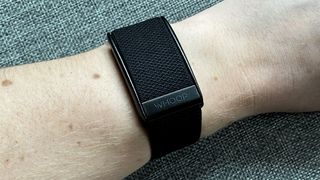
Whoop Strap 3.0 price and release date
The Whoop Strap 3.0 is available now, and you can only buy one with a Whoop membership.
A membership costs $30 / £30 / AU$44 if you want to pay monthly without a big commitment – although there is a six-month minimum term with this option.
There’s also an annual membership. This works out at $24 / £24 / AU$32 per month – a 20% discount on the monthly price. The catch is you do need to pay it all in one go at $288 /£288 / AU$384.
Finally, there’s an $18 / £18 / AU$24 per month membership. This is also charged in one go at $324 / £324 / AU$432, but it’s a 40% saving on the original monthly price.
The membership model makes it difficult to compare the Whoop to other trackers in terms of value for money. For people who can’t afford to spend more than $300 / £300 / AU$550 on a new device in one go, it’s more accessible. For those who can’t commit to regular payments, it will be off-putting.
To add context, the Apple Watch Series 6 starts at £379 / $399 / $599AUD, and the Fitbit Sense is $329 / £299 / AU$499.95. These are large, one-off payments, but you don’t need a membership to use them.
Some services do allow you to unlock more features with a premium subscription, like Fitbit Premium. This is $9.99 / £7.99 / AU$14.99 per month or $79.99 / £79.99 / AU$129.99 for a one-off year-long payment.
But the Whoop isn’t going up against our pick of the best smartwatches. Instead, its screenless design, data collection, and focus on rest makes it more comparable to the Oura ring, which begins at $299 (around £210 / AU$386AUD).
Whoop Strap 3.0 design
The Whoop Strap 3.0 consists of an elasticated fabric strap and a simple plastic casing, which houses the sensors. There’s no screen or buttons, only lights on the edge to indicate Bluetooth pairing and charging. The Whoop is on your arm to collect data, and that’s it. This took some getting used to. I habitually looked down at the device to check the time and see my stats as I was working out.
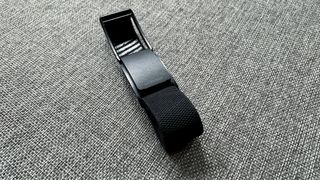
I didn’t think I’d like the design of the Whoop when it first arrived. The band had the texture of a seatbelt, and the fastening mechanism felt basic. But, after spending a few weeks with it, I now think it’s one of the most comfortable wearables I’ve ever tested and sits flush against my arm.
It has an IP rating of 68 and a 3ATM water resistance. It remains firmly in place and comfortable even when showering or sweating – but don’t take it diving or submerge it in water for longer than a swim session. You will want to take it off briefly while it dries – I had some mild skin irritation under the strap after a few days, but that was likely caused by soap or sweat rather than the strap itself.
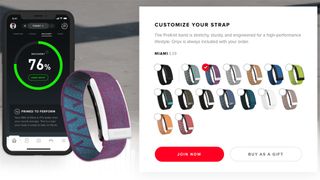
The Whoop I’m reviewing here is the simple black version – called Onyx – but there are 16 different color options, including grey, dark blue, denim blue, red and lime green.
You can also pick up different accessories, like a HydroBand, which dries faster than the knit options – ideal if you take the Whoop swimming or sweat a lot – or a high-viz option for those who like to work out at night.
Whoop Strap 3.0 health and fitness tracking
The Whoop Strap 3 focuses on three key areas: strain, recovery and sleep.
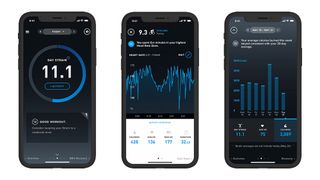
First up, there’s strain, and this is divided into two sections:
- Strain for the whole day
- Strain for a specific activity
For each, there’s a rating from one to 21. To work this out, the Whoop measures the cardiovascular load you’ve undergone and compares it to the total cardiovascular load you were capable of taking on. It uses your heart rate data to figure this out, measuring the energy you’ve exerted when entering different heart rate zones.
This might seem like an arbitrary scale, but it quickly becomes easy to understand after you track a few activities. For example, a challenging workout that pushes you to your limit and your maximum heart rate might get a strain score of 18. A moderate activity might hit 10 to 14, and a casual walk will score below 10. This is personalized, accounts for differences in fitness and ability, and gets more accurate over time.
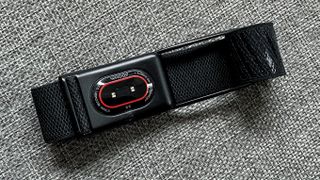
The day strain score takes into account all your workouts, as well as any other movement you do throughout the day. This is appealing to me because many other trackers can only tell you how much you’ve worked out. Whereas the Whoop informs you not only about your workouts, but the effect they’ve had on you, and the effect the day generally has had on you. For example, I noticed high levels of strain on a day when I ran a few errands and did a lot of cleaning but didn’t work out. I’d have never guessed this would have resulted in a high strain day but finding out was invaluable in managing my energy level over the days that followed.
The Whoop can track a wide range of activities. Many of these can also be tracked via GPS from your phone to collect location data, including commuting, cycling, golf, mountain biking and swimming. There’s also some app integration with Strava and TrainerRoad – although the Whoop Strap 3 won’t send data to Apple Health or Google Fit.
Although the Whoop can track your workouts, heart rate monitoring accuracy is essential here – it’s what so many scores and recommendations are based on.
In a side-by-side comparison with the Fitbit Versa 2 during a number of workouts I was happy to find they showed almost identical heart rate readings throughout. During a 30-minute spinning session, the Versa 2 recorded my average heart rate at 116bpm, the Whoop went a bit lower to 112bpm, but the highs and the lows were (for the most part) the same.
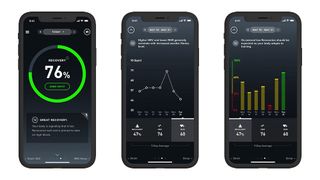
Next up, there’s recovery. According to Whoop, this is all about how prepared your body is to take on strain.
This is measured as a percentage, so if your recovery is high, like more than 67%, that’s the green zone, and you can have a high-energy, high-strain day. When it’s low, like 33% and below, you’re in the red zone. This means you might be at greater risk of injury or overtraining during intense workouts.
Recovery is calculated using a combination of metrics, including resting heart rate, heart rate variability, respiratory rate, and sleep performance. Interestingly, it gets better over time as Whoop learns more about your baseline and lifestyle.
Just like the strain data, I found the recovery information overwhelming and a bit meaningless. But as it became more personalized, it helped me decide what kind of workouts I’d do each day and how much I’d push myself. Some people might tap into their energy levels without the need for a wearable. I have a history of over-exercise and a knee injury, so this kind of hand-holding informed by insights was welcome.
Sleep is also displayed as a percentage. It’s determined by the time you spent asleep, your heart rate and respiratory rate throughout the night, as well as the different sleep stages you entered throughout the night.
I found sleep tracking to be highly accurate and got similar results from my Fitbit Versa 2 in terms of sleep stages and duration. It’s no surprise one study claimed that Whoop is one of the most precise sleep monitors currently on the market.
That’s a lot of data, but the app is designed to help you make sense of it – as long as you can handle that every aspect of your life is rated.
Whoop strap 3.0 companion app
I had some teething issues with the Whoop in the first few days, down to a problem with updates. The device needed three software updates within an afternoon, and the app didn’t notify me, which caused some charging and connectivity issues. Luckily, these problems were solved quickly, and after that, the device and the app worked very well together. Data syncs quickly with the app, and there’s a handy status bar to show you the device is connected and how much battery is left.
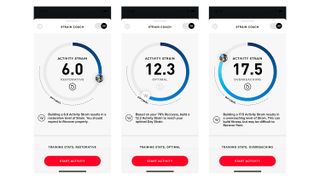
There’s so much data about you and your body to comb through. Still, Whoop makes it easy with color-coded insights, clear presentation and a significant amount of extra info and coaching within the app to make all of the numbers mean something.
For example, to help you make sense of the data about strain, a feature called the Strain Coach is unlocked after a week’s worth of use. This tells you how much to push yourself before you begin a new workout. Once you’ve reached your desired strain level, you can watch your activity strain increase in real-time – as long as you can keep your phone on you – and you’ll be notified when you’ve hit your goal.
The Strain Coach is just one element of the Coaching section of the app, this fills out the more you use it. This is where you’ll also find the very handy Sleep Coach, which provides you with recommendations about when you should get to sleep depending on how you want to feel the next day, as well as performance assessments, which are revealed as you fill out more and more data.
There are also pop-ups, which tell you which elements are unlocked and what Whoop is learning about you each day. As useful as these were, a screen sizing issue on iOS meant it was difficult to get rid of them without closing the app completely each time.
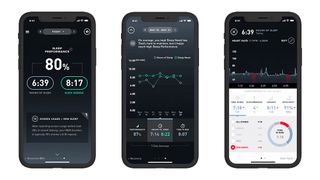
The app is also where you’ll find a feature called Whoop Live, which lets you record a video of your workout with heart rate data over the top, as well as Whoop Teams, a social feature that enables you to join groups to stay motivated.
A feature called HR broadcast allows you to send your heart rate data to compatible devices, like Peloton and Wahoo computers. However, this could be why the Whoop was so easily discoverable and easy to connect to with Bluetooth via other people’s smartphones. My partner connected to the Whoop from his phone – even without the app or Bluetooth pairing mode activated.
What’s more, in the Bluetooth settings on his phone there was, strangely, no option to disconnect or forget the Whoop like there usually is. As far as I know, he’s still connected to it, which might not sound like a big deal, but we know devices that run on Bluetooth Low Energy – like the Whoop Strap 3 – could be vulnerable to attacks.

Whoop Strap 3.0 battery
According to Whoop, you can expect a five-day battery life from the Strap 3.0. This largely depends on how many workouts you use it to track. I got about 4.5 days out of it on one charge, which was good considering I used it for at least one hour-long workout a day and many walks.
To charge the Whoop, you’ll need to slide it into its charging cradle, which is juiced up via USB. This means you can wear it while it charges if you don’t want to miss out on anything. During our testing, it charged up quickly from zero to full in around an hour and 15 minutes.

Buy it if
You take training seriously
You can use the Whoop for casual workouts and the odd gym session. But you’d be better suited to a device that does other things too – like the Fitbit Versa 3, with a screen and smartwatch features. The Whoop is a good idea for those who work out regularly and care about upgrading their performance whilst avoiding injury.
You want a minimal design
The Whoop is designed to be strapped on and forgotten about. You get on with things and check the app when you need to. That’s why its minimal design is perfect. So if you don’t need a fancy smartwatch but want something simple and functional, the Whoop will work for you.
You love data
There are simple scores at the top of each section of the app that give you a quick overview of your strain, recovery and sleep. But there’s a lot of data here, and you need to feel excited by the prospect of wading through it and taking the time to pay attention to the personalized recommendations to make a Whoop worth it – only data nerds should sign-up.
Don't buy it if
You want smartwatch features
There’s no screen on the Whoop, which means there are no apps or smartwatch features here. If you want quick access to notifications, to check your schedule or to see stats from your wrist as you workout, this isn’t the tracker for you.
Fitness isn’t your first priority
There’s a lot to love about the Whoop, and sleep tracking is fantastic, but you really need to care about working out and recovery for it to be worth it for you. Other devices do other things – sleep tracking, notifications, etc. – well, so if you don’t care about fitness, look for alternatives.
A membership doesn’t suit you
You can only buy the Whoop if you have a membership. Whether this is right for you or not will depend on your budget and your cash flow. Some people will prefer a smaller amount each month rather than a one-off payment, but it won’t suit others for that reason. The commitment of membership further proves this isn’t for casual users.
- We've tested and ranked the best running watches
Becca is a contributor to TechRadar, a freelance journalist and author. She’s been writing about consumer tech and popular science for more than ten years, covering all kinds of topics, including why robots have eyes and whether we’ll experience the overview effect one day. She’s particularly interested in VR/AR, wearables, digital health, space tech and chatting to experts and academics about the future. She’s contributed to TechRadar, T3, Wired, New Scientist, The Guardian, Inverse and many more. Her first book, Screen Time, came out in January 2021 with Bonnier Books. She loves science-fiction, brutalist architecture, and spending too much time floating through space in virtual reality.


